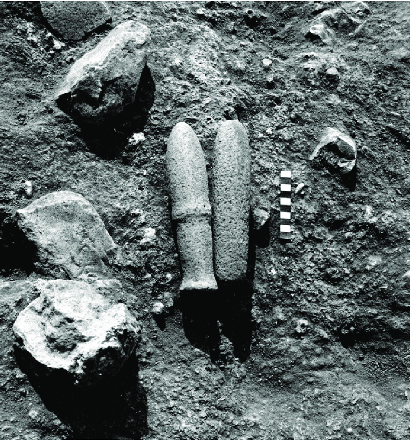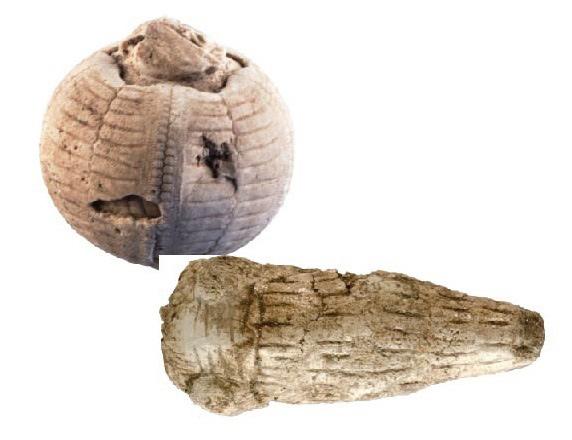You are here
Excavation at Wadi Hammeh 27 reveals Natufian burial practices, early village life
By Saeb Rawashdeh - Nov 25,2024 - Last updated at Nov 25,2024

A Natuffian house in Wadi Hammeh (Photo courtesy of ACOR)
AMMAN — According to Associate Professor Phillip Edwards from the La Trobe University, the major objective of the 2024 season in Jordan was to conserve and analyse human skeletal remains and artefacts from the large multiple burial, excavated in 2022 from the Natufian site, Wadi Hammeh 27, located in north-western Jordan.
"Wadi Hammeh 27 [12,000 - 12,500 BC] produced some of the first archaeobotanical remains retrieved from an Early Natufian site. The occupants harvested wild barley with a diverse range of bone and flint sickles, and also collected lentils, pistachios, and a range of other small-seeded plants," Edwards said.
During the season, the team excavated graves established below the lowest phase of buildings in the settlement.
Around 12,500 BCE, the occupants of Wadi Hammeh 27 in Jordan founded a burial ground and defined its boundary with complex marker features, the professor said, adding that relatively quickly, they proceeded to build houses over these graves.
"Their village lasted for 500 years, but no-one was ever buried at the site again. Instead, we find burnt fragments of burnt human skulls scattered in the upper occupation layers, a unique custom for this period. So, these earliest founders were evidently quite important. Their positions were marked by stone and earthen features repeatedly built in successive layers over 500 years," Edwards underlined, adding that burials have been found in four different contexts, all quite different from one another:
Feature 8 (Plot XX F)
A single adult flexed burial, with a large rock placed over the upper body.
Feature 7 (Plot XX J)
A secondary multiple burial, with remains of up to seven adults, featuring several skulls placed in the grave at different times.
Feature 29 (Plot XX F) Feature 29 contained two children placed on top of each other, buried individually in shrouds and with their heads resting on separate stone pillows. They were probably interred together, with only minutes occurring between each deposition. One child wore a Tusk shell necklace.
Feature 37 (Plot XX F)
A large, multiple burial discovered in 2022. The grave pit is not completely excavated yet, but already up to 8 individuals have been identified from a jumble of long bones and skulls crammed into the top layer of the pit. The burials are accompanied by a rich assemblage of ornaments and artefacts, including a cache of five elegant bone points, a number of bracelets or anklets strung from marine Tusk shells, a complex necklace of Tusk shells, bird bones and gazelle toe bones, and a necklace of articulated bird bones, with traces of cordage still preserved.
Regarding the occupancy of the site, " Wadi Hammeh 27 [12,000 - 12,500 BC], is one of Jordan’s and the world's first village settlements, founded by hunter gatherers near the end of the last Ice Age," Edwards said, noting that three superimposed phases of houses were built over a series of foundational burials.
They take the form of a number of oval, stone huts and a variety of associated features such as hearths, postholes and pavements, he continued, adding that material culture included a varied repertoire of rock-art, ranging from large-scale incised slabs to small plaques; many artefact types in flint, limestone, basalt and animal bone; ochre and shell fragments; a diverse array of prey birds, fish, reptiles and animals, and rare plant-food remains.
"The idea of continuous occupation in this period versus a series of seasonal occupations has long been uncertain. Lauren Prossor’s recently completed [from Australian National University] doctoral thesis, based on the micromorphological analyses of sediments, presents evidence to demonstrate continuous occupation of the site through 500 years, and that much of the sediment mass is composed of collapsed adobe, indicating that the upper parts of the houses were much more substantial than has previously been understood," Edwards underscored.
Related Articles
AMMAN — Different teams of Australian archaeologists have been "very active" in northern and northwestern parts of Jordan.
AMMAN — Hundreds of thousands of miniscule stone flakes, some only millimeters in length, the scattered results of the hammering and bashing
AMMAN — Wadi Hammeh 27, located 2 kilometres north of Pella, represents one of the largest and most complex Natufian base-camps in the south














